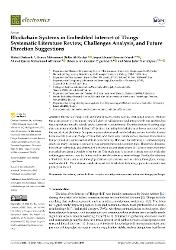| dc.contributor.author | Darbandi, Mehdi | |
| dc.contributor.author | Al-Khafaji, Hamza Mohammed Ridha | |
| dc.contributor.author | Nasab, Seyed Hamid Hosseini | |
| dc.contributor.author | AlHamad, Ahmad Qasim Mohammad | |
| dc.contributor.author | Ergashevich, Beknazarov Zafarjon | |
| dc.contributor.author | Navimipour, Nima Jafari | |
| dc.date.accessioned | 2023-10-19T15:12:03Z | |
| dc.date.available | 2023-10-19T15:12:03Z | |
| dc.date.issued | 2022 | |
| dc.identifier.issn | 2079-9292 | |
| dc.identifier.uri | https://doi.org/10.3390/electronics11234020 | |
| dc.identifier.uri | https://hdl.handle.net/20.500.12469/5329 | |
| dc.description.abstract | Internet of Things (IoT) environments can extensively use embedded devices. Without the participation of consumers; tiny IoT devices will function and interact with one another, but their operations must be reliable and secure from various threats. The introduction of cutting-edge data analytics methods for linked IoT devices, including blockchain, may lower costs and boost the use of cloud platforms. In a peer-to-peer network such as blockchain, no one has to be trusted because each peer is in charge of their task, and there is no central server. Because blockchain is tamper-proof, it is connected to IoT to increase security. However, the technology is still developing and faces many challenges, such as power consumption and execution time. This article discusses blockchain technology and embedded devices in distant areas where IoT devices may encounter network shortages and possible cyber threats. This study aims to examine existing research while also outlining prospective areas for future work to use blockchains in smart settings. Finally, the efficiency of the blockchain is evaluated through performance parameters, such as latency, throughput, storage, and bandwidth. The obtained results showed that blockchain technology provides security and privacy for the IoT. | en_US |
| dc.language.iso | eng | en_US |
| dc.publisher | Mdpi | en_US |
| dc.relation.ispartof | Electronics | en_US |
| dc.rights | info:eu-repo/semantics/openAccess | en_US |
| dc.subject | Security | En_Us |
| dc.subject | Iot | En_Us |
| dc.subject | Architecture | En_Us |
| dc.subject | Model | En_Us |
| dc.subject | Interference | En_Us |
| dc.subject | Technology | En_Us |
| dc.subject | Framework | En_Us |
| dc.subject | Devices | En_Us |
| dc.subject | Privacy | En_Us |
| dc.subject | Edge | En_Us |
| dc.subject | blockchain | en_US |
| dc.subject | embedded device | en_US |
| dc.subject | cyber security | en_US |
| dc.subject | secure system | en_US |
| dc.subject | internet of things | en_US |
| dc.subject | challenges | en_US |
| dc.title | Blockchain Systems in Embedded Internet of Things: Systematic Literature Review, Challenges Analysis, and Future Direction Suggestions | en_US |
| dc.type | review | en_US |
| dc.authorid | Jafari Navimipour, Nima/0000-0002-5514-5536 | |
| dc.authorid | Al-Khafaji, Hamza Mohammed Ridha/0000-0003-3620-581X | |
| dc.authorid | AlHamad, Ahmad/0000-0002-7083-5375 | |
| dc.identifier.issue | 23 | en_US |
| dc.identifier.volume | 11 | en_US |
| dc.department | N/A | en_US |
| dc.identifier.wos | WOS:000936409400001 | en_US |
| dc.identifier.doi | 10.3390/electronics11234020 | en_US |
| dc.identifier.scopus | 2-s2.0-85143689478 | en_US |
| dc.institutionauthor | N/A | |
| dc.relation.publicationcategory | Diğer | en_US |
| dc.authorwosid | Jafari Navimipour, Nima/AAF-5662-2021 | |
| dc.authorwosid | Nasarian, Elham/ISB-6863-2023 | |
| dc.authorwosid | Al-Khafaji, Hamza Mohammed Ridha/D-6335-2019 | |
| dc.khas | 20231019-WoS | en_US |
















